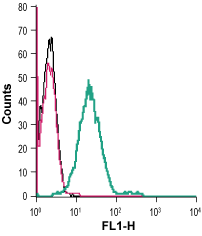Overview
- Peptide CKQSFRHAYPLTGH, corresponding to amino acid residues 294 - 307 of mouse GPER1 (Accession Q8BMP4). 3rd extracellular loop.

 Western blot analysis of rat (lanes 1 and 3) and mouse (lanes 2 and 4) brain lysates:1,2. Anti-GPER1/GPR30 (extracellular) Antibody (#AER-049), (1:200).
Western blot analysis of rat (lanes 1 and 3) and mouse (lanes 2 and 4) brain lysates:1,2. Anti-GPER1/GPR30 (extracellular) Antibody (#AER-049), (1:200).
3,4. Anti-GPER1/GPR30 (extracellular) Antibody, preincubated with GPER1/GPR30 (extracellular) Blocking Peptide (#BLP-ER049). Western blot analysis of human MCF-7 breast adenocarcinoma (lanes 1 and 4), human THP-1 monocytic leukemia (lanes 2 and 5) and human Jurkat T-cell leukemia (lanes 3 and 6) cell line lysates:1-3. Anti-GPER1/GPR30 (extracellular) Antibody (#AER-049), (1:200).
Western blot analysis of human MCF-7 breast adenocarcinoma (lanes 1 and 4), human THP-1 monocytic leukemia (lanes 2 and 5) and human Jurkat T-cell leukemia (lanes 3 and 6) cell line lysates:1-3. Anti-GPER1/GPR30 (extracellular) Antibody (#AER-049), (1:200).
4-6. Anti-GPER1/GPR30 (extracellular) Antibody, preincubated with GPER1/GPR30 (extracellular) Blocking Peptide (#BLP-ER049).
- Vrtačnik, P. et al. (2014) Biochem. Med. 24, 329.
- Hadjimarkou, M.M. and Vasudevan, N. (2018) J. Steroid Biochem. Mol. Biol. 176, 57.
- Nilsson, B.O. et al. (2011) Br. J. Pharmacol. 163, 1131.
GPER1/GPR30 is an estrogen receptor belonging to the superfamily of G-protein coupled receptors (GPCRs). Like all members, GPER1 has seven membrane-spanning domains, an extracellular N-terminus and a cytoplasmic C-terminal domain. It is widely expressed in the central nervous system (CNS) and it binds 17β-estradiol (17β-E) with high affinity1.
Estrogens have long been known as important regulators of the female reproductive functions, however, is now commonly accepted that estrogens and androgens have important functions in both female and male physiology and pathology.
As opposed to the epigenetic regulatory role in estrogen signaling carried out by ER-α and ER-β estrogen receptors, signaling from GPER1 is responsible for the rapid non-genomic actions of estrogens that activate various protein-kinase cascades1. GPER1 signaling improves spatial memory, possibly via release of neurotransmitters. In addition, GPER1 activation contributes to behaviors that denote anxiety, and to social behaviors such as social memory and lordosis behavior in mice. In the male hippocampus, GPER1 activation leads to phosphorylation of the classical estrogen receptor ERα, suggesting that crosstalk with ERα is important in the manifestation of these behaviors, many of which are absent in ERα-null mice2. GPER1 activation also has several beneficial effects in the cardiovascular system including vasorelaxation, inhibition of smooth muscle cell proliferation, and protection of the myocardium against ischemia/reperfusion injury, and in the metabolic system including stimulation of insulin release and protection against pancreatic β-cell apoptosis. Thus, GPER1 is emerging as a candidate therapeutic target in both cardiovascular and metabolic diseases3.
Application key:
Species reactivity key:
Anti-GPER1/GPR30 (extracellular) Antibody (#AER-049) is a highly specific antibody directed against an epitope of the mouse protein. The antibody can be used in western blot and indirect live cell flow cytometry applications. It has been designed to recognize GPER1 from rat, mouse, and human samples.

